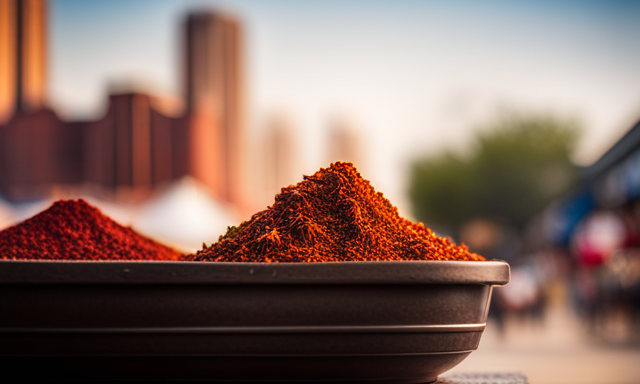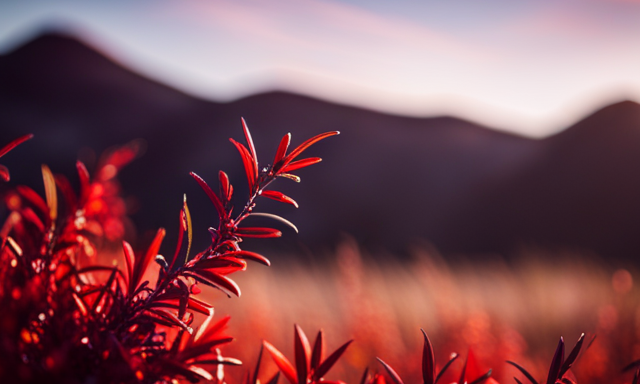I have discovered a fascinating way to cultivate and enjoy the benefits of rooibos plants right in my own backyard. By planting rooibos seeds, I can create a bountiful supply of this delicious and healthful herbal tea. In this article, I will guide you through the step-by-step process of successfully growing rooibos from seeds, ensuring a thriving and abundant harvest.
First, we will gather all the necessary materials, including quality seeds and suitable gardening tools. Then, we will prepare the soil, creating the ideal conditions for the seeds to germinate and flourish.
Next, we will carefully plant the seeds, paying attention to proper spacing and depth. Providing consistent watering and ample sunlight, we will nurture the seedlings as they emerge and develop.
Once the seedlings have matured, we will learn how to transplant them into larger containers or directly into the garden. We will also discuss the ongoing care and maintenance required to ensure the plants continue to thrive.
Finally, we will explore the exciting process of harvesting the leaves and enjoying the flavorful and soothing rooibos tea that we have cultivated with our own hands.
Are you ready to embark on this rewarding gardening journey? Let’s get started!
Key Takeaways
- Choose well-draining potting mix and containers for optimal growth
- Nurture seedlings in a warm environment with adequate light and regular watering
- Prune and shape plants to promote air circulation and prevent diseases
- Monitor for pests and diseases, and use organic pest control methods when necessary
Gather the Necessary Materials
Now it’s time for you to gather all the materials you’ll need to plant your rooibos seeds.
Choosing the right pot size is crucial for the successful growth of your rooibos plant. Opt for a pot that’s at least 8 inches in diameter and has drainage holes to ensure proper water circulation.
Understanding the germination process is also essential. Rooibos seeds require a period of cold stratification before they can sprout. This can be achieved by placing the seeds in a moist paper towel and refrigerating them for about a month.
Additionally, you’ll need potting soil, perlite, and a spray bottle to maintain the moisture levels.
Once you have gathered all the necessary materials, you can move on to preparing the soil for planting your rooibos seeds.
Prepare the Soil
To prepare the soil for planting rooibos seeds, I first choose a suitable container that’ll provide enough space for the seeds to grow.
Next, I fill the container with potting soil, making sure it’s well-drained and nutrient-rich.
Finally, I moisten the soil to create the ideal environment for the seeds to germinate and establish roots.
Choose a suitable container
First, you’ll need to find a suitable container for planting your rooibos seeds. Remember, "a stitch in time saves nine" when choosing the right size. The container should be large enough to accommodate the growth of the rooibos plant, but not excessively big as it may hinder proper root development. Choosing the right size is crucial for the success of your rooibos seeds.
Here are three options for containers:
- Clay pots: These provide good drainage and insulation for the roots.
- Plastic containers: They are lightweight and easy to move around.
- Recycled containers: Consider using alternative containers such as old buckets or wooden boxes, just make sure they have drainage holes.
After selecting the suitable container, it’s time to move on to the next step: filling it with potting soil. This will provide the necessary nutrients and support for the rooibos seeds to grow into healthy plants.
Fill the container with potting soil
Once you’ve chosen the perfect container, it’s time for you to fill it with nutrient-rich potting soil. This will ensure a solid foundation for your future flourishing plants. When it comes to choosing the right potting soil for rooibos seeds, it’s important to opt for a well-draining mix that retains moisture. Look for a soil that’s specifically formulated for seed starting or one that’s light and airy, as this’ll provide the necessary aeration and drainage for successful germination.
Additionally, ensure that the potting soil is moist but not overly saturated before planting your rooibos seeds. This’ll create a favorable environment for seedling development.
Now that you have filled your container with potting soil, it’s time to transition into the subsequent section about moistening the soil, a crucial step in the planting process.
Moisten the soil
Now, you’ll want to make sure the soil is nice and moist, creating a welcoming environment for your future plants to thrive.
Soil preparation is a crucial step in the planting process as it sets the foundation for successful growth. To properly moisten the soil, follow these watering techniques:
- Use a spray bottle or watering can with a fine mist setting to avoid disturbing the seeds or compacting the soil.
- Water the soil evenly, ensuring it’s damp but not waterlogged.
Monitor the moisture levels regularly and adjust watering accordingly to prevent overwatering or drying out.
By providing adequate moisture, you’re giving the rooibos seeds the best chance to germinate and establish strong roots.
Once the soil is properly moistened, you can move on to the next step of planting the seeds and nurturing their growth.
Plant the Seeds
To get your rooibos seeds growing, all you need to do is simply pop them in the soil and watch the magic happen! The germinating process of rooibos seeds requires proper temperature conditions. It’s important to ensure that the soil is warm enough, ideally between 20 to 25 degrees Celsius, for successful germination.
Plant the seeds at a depth of approximately 1 centimeter, making sure they’re evenly spaced. Gently cover the seeds with soil and lightly press down to secure them.
It’s crucial to provide proper watering and sunlight for the seeds to thrive. Ensure the soil remains moist but not waterlogged, and place the pots in a sunny location with at least six hours of direct sunlight per day.
By following these steps, your rooibos seeds will be on their way to becoming healthy plants ready for harvesting and brewing!
Provide Proper Watering and Sunlight
To ensure successful growth, it’s crucial to water the rooibos seeds regularly. This will help provide the necessary moisture for germination and early growth.
Additionally, placing the container in a sunny location is essential as it allows for proper photosynthesis and promotes healthy plant development.
Lastly, monitoring the soil moisture levels is important to prevent over or under watering, which can negatively impact the growth of the rooibos plants.
Water the seeds regularly
Regularly watering the seeds will ensure their growth, making you feel gratified as you watch the vibrant rooibos plants blossom. To achieve optimal growth, it is crucial to provide the proper watering frequency and sunlight. Watering the seeds too much or too little can hinder their development. It is essential to strike a balance and avoid waterlogging the soil, as this can lead to root rot and stunted growth. On the other hand, insufficient watering can cause the seeds to dry out and die. To help you monitor the watering process effectively, refer to the table below:
| Time | Watering Frequency | Amount |
|---|---|---|
| Morning | Every day | 1-2 tablespoons |
| Afternoon | Every day | 1-2 tablespoons |
| Evening | Every day | 1-2 tablespoons |
By following this watering schedule, your rooibos seeds will receive the ideal amount of moisture required for their growth. With the watering aspect covered, let’s now move on to the next step of placing the container in a sunny location.
Place the container in a sunny location
Position the container in a sun-kissed spot to provide the perfect environment for your growing rooibos plants. Placing the container in a sunny location offers several benefits for the seeds to thrive. Here’s why a sunny spot is crucial for successful growth:
-
Optimal Sunlight: Rooibos plants require ample sunlight to produce energy through photosynthesis. Positioning the container in a sunny location ensures they receive the necessary light for this process.
-
Vitamin D Synthesis: Sunlight aids in the synthesis of vitamin D in rooibos plants, which contributes to their overall health and vitality.
-
Enhanced Flavor: Sunlight exposure enhances the flavor profile of rooibos leaves, resulting in a more satisfying brew.
-
Morning Sun: The morning sun is generally the best time for sunlight, as it provides gentle, warm rays that promote steady growth.
To monitor soil moisture levels effectively, it is essential to… [transition to the next section].
Monitor soil moisture levels
Make sure you keep an eye on how moist the soil is in order to give your growing rooibos plants the best chance for success. Proper drainage is crucial for maintaining the right soil moisture levels. Excess water can lead to root rot and other diseases.
To ensure good drainage, choose a well-draining potting mix and use containers with drainage holes. Additionally, consider using mulch to retain soil moisture in rooibos plantations. Organic mulch, such as straw or wood chips, helps to prevent evaporation and keeps the soil moist for longer periods. Mulching also regulates soil temperature and suppresses weed growth.
By monitoring soil moisture levels and implementing proper drainage techniques, you can create an optimal growing environment for your rooibos plants. This will set the stage for successful seedling nurture in the next section.
Nurture the Seedlings
While tending to the rooibos seedlings, it’s crucial to create a nurturing environment that fosters their growth. Careful attention to nurturing techniques and seedling care will ensure the successful development of healthy plants. Here are some key practices to follow:
-
Maintain a consistent temperature: Keep the seedlings in a warm environment, ideally around 70-85°F (21-29°C), to promote optimal growth.
-
Provide adequate light: Ensure the seedlings receive 12-14 hours of light daily, either from natural sunlight or artificial sources like fluorescent grow lights.
-
Water wisely: Water the seedlings regularly, keeping the soil moist but not waterlogged. Aim for a well-drained soil mix to prevent root rot.
-
Fertilize appropriately: Apply a balanced, water-soluble fertilizer every two weeks to provide essential nutrients for healthy growth.
By implementing these nurturing techniques and diligently caring for the seedlings, they’ll thrive and be ready for the subsequent section on transplanting the seedlings.
Transplanting the Seedlings
Once the seedlings have reached a sufficient size, it’s time to carefully transfer them to their permanent pots or garden beds.
Transplanting the seedlings requires specific techniques to ensure their successful growth. Start by preparing the new pots or garden beds with well-draining soil that’s rich in organic matter.
Gently remove the seedlings from their current containers, being careful not to damage the delicate roots. Place each seedling in its new location, ensuring that it’s planted at the same depth as before. Lightly press the soil around the seedling to provide stability.
After transplanting, water the seedlings thoroughly to help them establish in their new environment. Continued care and maintenance, such as regular watering and protection from extreme temperatures, are essential for their healthy growth.
Continued Care and Maintenance
After transplanting the seedlings, it’s crucial to water them regularly to ensure their proper growth and development. Pruning and shaping the plants helps in maintaining their desired form and structure, promoting better air circulation, and reducing the risk of diseases.
It’s also important to monitor the plants for any signs of pests and diseases. Early detection and treatment can prevent significant damage to the crop.
Water the transplanted seedlings
To properly care for your transplanted rooibos seedlings, make sure you water them regularly. Studies have shown that properly hydrated plants have a 30% higher survival rate. Watering techniques are crucial to manage soil moisture levels effectively. Here are some important points to consider:
-
Consistency: Water the seedlings consistently, ensuring that the soil remains moist but not waterlogged. Avoid overwatering as it can lead to root rot.
-
Timing: Water the plants early in the morning or late in the evening to minimize evaporation and allow the roots to absorb moisture effectively.
-
Depth: Water deeply, ensuring that the water reaches the root zone. Shallow watering can result in weak root systems.
Maintaining proper water levels for your rooibos seedlings is vital for their overall growth and development. Once you’ve mastered the art of watering, it’s time to move on to the next step: prune and shape the plants.
Prune and shape the plants
Pruning and shaping the plants is essential for promoting their healthy and desired growth. When it comes to rooibos plants, employing proper pruning techniques and shaping methods is crucial.
Regular pruning helps maintain the shape and size of the plants, ensuring optimal sunlight penetration and air circulation. This, in turn, promotes the overall health and vigor of the plants. Pruning should be done during the dormant season, typically in late winter or early spring.
Removing dead or diseased branches, as well as any overcrowded growth, helps prevent the spread of pests and diseases. Shaping the plants can be achieved by selectively removing branches to achieve a desired form or structure. By following these pruning and shaping methods, the rooibos plants can thrive and flourish.
Transitioning into the subsequent section about ‘monitor for pests and diseases’, it is important to maintain a vigilant eye on the plants to ensure their continued well-being.
Monitor for pests and diseases
Keep an eagle eye on your flourishing rooibos bushes, as pests and diseases can creep in unnoticed, like a stealthy predator in the night. To ensure the health of your plants, follow these pest control measures and be aware of common diseases:
- Monitor for aphids, spider mites, and caterpillars that can damage the leaves and stems.
- Implement organic pest control methods such as neem oil spray or introducing beneficial insects like ladybugs.
Watch out for rooibos rust, a fungal disease that causes orange-brown lesions on the leaves.
Be vigilant against root rot, which can occur due to overwatering or poorly drained soil.
Prevent powdery mildew by maintaining proper air circulation and avoiding excess humidity.
By diligently monitoring and taking action against pests and diseases, you can protect your rooibos plants and ensure a successful harvest. Transitioning into the subsequent section about ‘harvesting and enjoying your rooibos plants’, remember to keep a watchful eye even after the plants have matured.
Harvesting and Enjoying Your Rooibos Plants
Once your vibrant rooibos plants have reached maturity, you can savor the delightful flavor of your homegrown tea by carefully plucking the tender leaves and gently drying them in the sun.
Harvesting the leaves at the right time ensures optimal taste and health benefits. When plucking, it’s important to select the youngest and freshest leaves, as they contain the highest concentration of antioxidants and essential oils.
After harvesting, spread the leaves out in a thin layer on a clean, dry surface, preferably in direct sunlight. Allow them to dry completely, which usually takes about a day or two.
Once dried, store the leaves in an airtight container to preserve their flavor and aroma.
To enjoy the health benefits of rooibos tea, simply brew a cup by steeping a teaspoon of dried leaves in hot water for about 5-7 minutes. Sip and savor the natural goodness of your homegrown rooibos tea.
Frequently Asked Questions
How long does it take for rooibos seeds to germinate?
Rooibos seeds typically take around 7-10 days to germinate, but this can vary depending on optimal conditions. Providing the right temperature, moisture, and light levels will ensure a successful germination timeline.
Can rooibos plants tolerate frost?
Rooibos plants have a moderate frost tolerance and can survive cold weather conditions. However, prolonged exposure to freezing temperatures can damage the plant. It is important to provide protection during extreme cold spells.
Are rooibos plants susceptible to any common pests or diseases?
Rooibos plants are remarkably resilient, but they are susceptible to a few common pests and diseases. Prevention is key, and regular inspection, proper watering, and the use of organic pesticides can help keep these issues at bay.
How often should rooibos plants be fertilized?
Rooibos plants should be fertilized every 2-3 months using an organic or synthetic fertilizer. Organic fertilizers provide nutrients slowly over time, while synthetic fertilizers deliver nutrients more quickly.
Can rooibos plants be grown indoors or do they require outdoor conditions?
Rooibos plants can be grown indoors in a greenhouse, but they require specific conditions. Common challenges when growing rooibos indoors include maintaining proper temperature, humidity, and light levels to mimic outdoor conditions.
Conclusion
In conclusion, planting rooibos seeds requires dedication, patience, and attention to detail. By gathering the necessary materials, preparing the soil, and providing proper watering and sunlight, you can successfully nurture the seedlings into healthy plants.
Transplanting the seedlings and continuing with care and maintenance will ensure their growth and development. Finally, the rewarding moment of harvesting and enjoying your own homegrown rooibos plants will fill you with a sense of accomplishment, satisfaction, and pure delight.
Start your rooibos planting journey today and experience the joy of cultivating this precious herb.










